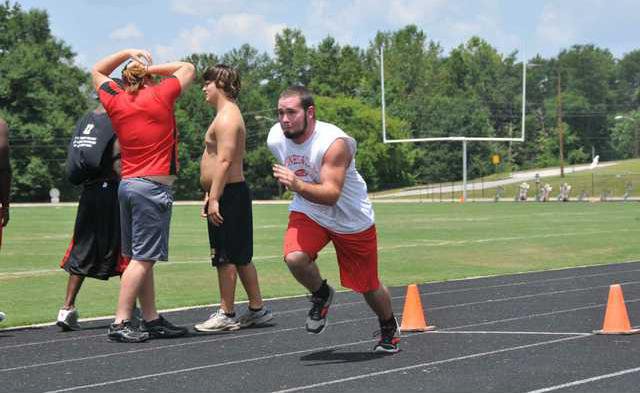Protecting the head in football: Long-term effects of concussions serious
Technology helping make sports safer
Kids can benefit from early weightlifting
With temperatures climbing into the upper 90s and sports teams holding summer practices, the risk of heat-related illnesses in young athletes is ever-present.
But this is not recent news. The health risks to athletes practicing in extreme heat has been well documented in the past few years.
Take the case of first-year Kentucky high school football coach David Jason Stinson. In Aug. 2008, 15-year-old offensive lineman Max Gilpin collapsed during summer practice while running sprints on a day when the heat index reached 94 degrees. Gilpin died a few days later from heat stroke. In Jan. 2009, Stinson was charged with reckless homicide in the young man’s death.
As recently as early July, two assistant football coaches at Middletown High School in Maryland were charged with second-degree reckless endangerment after a player collapsed during a strength and conditioning session. Police said the temperature at the time was 93 degrees and no water was provided to the players during the training.
These examples are just two of many in a frightening trend. In a recent report released by the University of North Carolina, researchers claimed that 33 football players have died from heat stroke since 1995.
So how can young athletes be protected while participating in the heat?
Holmes Marchman, a doctor who focuses on sports-related injuries and is a founding member of the Longstreet Clinic in Gainesville, said preventative measures are simple and obvious.
“The best methods of prevention are to exercise in the coolest parts of the day, usually early morning or late afternoon, and to take frequent breaks for hydration,” he said.
Hydration doesn’t solely consist of water. Marchman advises the use of sports drinks high in electrolytes, such as sodium and potassium, and low in sugar and calories.
“A big problem today are caffeine drinks,” Marchman said. “Those types of drinks are diuretics which make the kidneys get rid of more fluid than normal. That is the worst thing for an athlete who is practicing in extreme heat.”
Not only is hydration important, but the timing of the hydration.
“It is important to hydrate before the athlete begins to feel thirsty,” Marchman said. “If the athlete is already feeling thirsty, it may be too late to prevent the heat-related illness and you may have to move immediately to treatment.”Scott Anderson, the head athletic trainer at the University of Oklahoma, added to Marchman’s measures by stressing the importance of how a practice is structured.
“Heat illness needs to be considered an intensity syndrome,” Anderson said. “If you think of it more in terms of the critical factor being the intensity of the work as opposed to solely the environment, that will help keep athletes safer. The intensity of practice should be more of a roller-coaster effect.”
Instead of having a practice which runs at the same intensity throughout, Anderson believes a high-intensity period followed by a low-intensity period is key, especially early in the season when athletes are not in peak shape and aren’t acclimated to the heat.
Anderson agrees that hydration is key, but thinks too often it is assumed the if hydration is frequent enough there is no limit to the pace of work.
“Which is just not true,” Anderson said.
Coaches taking the advice of athletic trainers is key to keeping athletes safe; a fact that Gainesville High football coach Bruce Miller knows very well.
Gainesville High employs a full-time staff trainer who keeps the coaching staff aware of outside conditions. If the trainer believes the heat too intense, the coaches adjust practice accordingly.
“I’ll even delay going out if we have to,” Miller said. “Early in the season last year we practiced in shorts and shoulder pads just to try and lessen the wear and tear on the kids and keep them safe from such illnesses.”
Once practice begins, coaches and trainers keep an eye out for symptoms of heat-related problems.
Marchman said that heat exhaustion, characterized by dizziness and mental confusion, is the lesser of the two main illnesses and that if the exhaustion is not treated, it can progress to the more dangerous illness of heat stroke.
“With heat stroke, the core temperature becomes too high,” Marchman said. “When you get above 104 degrees internally, the organs start shutting down and you lose the ability to function.”
The most common symptoms of a heat stroke are confusion, anxiousness and headache, all of which can culminate in a seizure. Also, the skin is hot to the touch but remains dry while muscles begin to cramp and the heart rate quickens.
“All of which are signs of a dangerous situation,” Marchman said.
If it becomes apparent that such a situation has arisen, Marchman states that the “first thing you need to do is call 911.
Immediately. Do not wait. It is better to err on the side of caution.”
According to Marchman, the most important thing is cooling down the body and that the best way to do that is to put ice packs on the big blood vessels in the neck, groin and wrist but that “getting indoors where there is air conditioning is best.”
Anderson takes this one step further, advising a full-body submersion in an ice-bath.
“Whether it’s a tank, kiddie pool, whirlpool or bathing tub, ice-water immersion is the gold standard for treating heat illness,” Anderson said. “There is no case on record of any athlete dying of heat stroke if they have been immersed in ice water.
“If you assume that all they need to do is go sit under a tree and get something to drink, you put yourself at risk for that turning into a catastrophic situation.”

